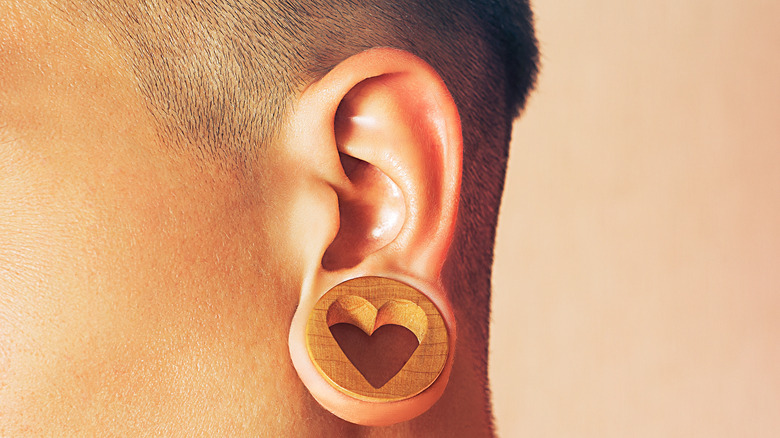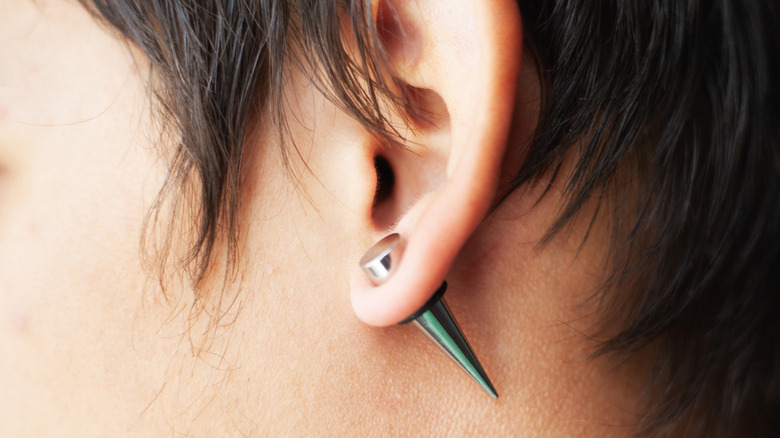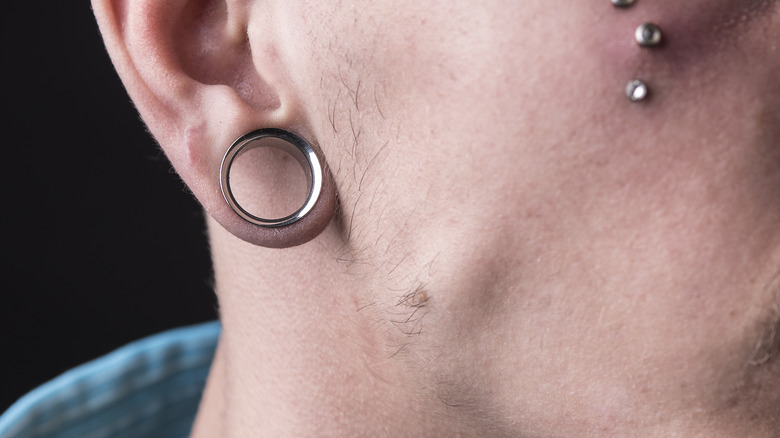Heres What You Should Know Before Getting Ear Gauges

When it comes to piercings, many people want to try new things and experiment with different types of jewelry. One of the biggest piercing trends is ear gauges. Simply put, ear gauging is the process of gradually stretching out holes in your earlobe using different size “plugs,” which are the jewelry used (via Healthline). Originally, gauging your ears was a form of “beauty enhancement” that began thousands of years ago, as seen in ice-age preserved humans, and still continues into modern times (via Healthline).
Today, many people like the look of ear gauges, as it gives them an edgy vibe. However, if you’re planning to gauge your ears, it’s a very careful and intricate process that requires professional guidance to ensure that you are doing it correctly and safely. As you’re stretching your actual earlobe, there’s a possibility that the lobe may never go back to normal. Therefore, consider the following before you begin the gauging process.
The ear gauging process

The first thing you need to do before gauging your ears is have your ears pierced and fully healed. It’s important to make sure your ear piercings are completely healed before beginning the gauging process to prevent infection (via Healthline).
When you are ready, you’ll need tapers, plugs, and lubricant. Tapers are pointed tools that begin the stretching process. They come in different sizes, most commonly from 3.2 mm to 12 mm. You’ll need the lubricant to coat the tapers to help them push more easily through your earlobe hole. Plugs are essentially the “earrings” that will be placed inside the hole to keep the skin stretched. They come in different materials, such as steel and silicone (via Healthline).
When you’re ready to begin gauging your ears, you should massage your earlobe to prepare. Make sure you wash your hands and sterilize your earlobe with alcohol. Then, insert the thinner end of the taper into your pierced hole. Make sure to go slowly. When you get the taper inserted, put your plug at the thicker end of the taper and continue moving the taper through, leaving the plug in the piercing. If you feel pain, you may be using tapers that are too big or pushing too hard.
Once your plugs are inserted, you want to make sure you treat your new gauges like a brand new ear piercing, cleaning them twice a day. You should also wait at least six weeks before gauging them again.
Things to consider when gauging your ears

While the process is fairly straightforward and is easy to do at home, there are many things that you should consider before gauging your ears. You may like the look at first and appreciate the “edge” it gives you, but there is a possibility that your earlobes won’t go back to their natural state after you’ve gauged them (via Bustle). When removing your plugs, if you leave them out long enough, your earlobe may shrink a bit, but definitely won’t go back to its original size. It all depends on a person’s skin and elasticity. If you do want to fix your gauged ears, it requires plastic surgery.
It’s also important that you don’t skip “sizes” when you are sizing up. Doing so can cause tears, leading to scar tissue. Built-up scar tissue can both interfere with further stretching and also prevent piercings from “going back down” (via Bustle).
In addition, when you begin gauging, you should probably consult a professional for guidance and advice on the right tools, materials, and process. One girl on YouTube tried to DIY her ear gauges and accidentally ripped her earlobe in half (via Bustle). Ouch!
Source: Read Full Article
